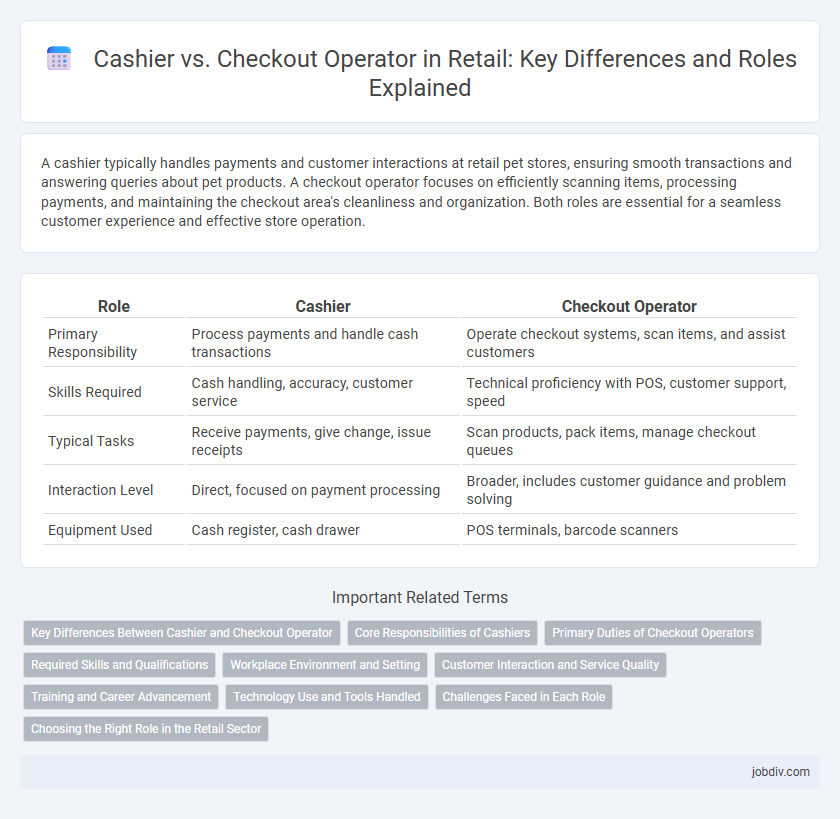A cashier typically handles payments and customer interactions at retail pet stores, ensuring smooth transactions and answering queries about pet products. A checkout operator focuses on efficiently scanning items, processing payments, and maintaining the checkout area's cleanliness and organization. Both roles are essential for a seamless customer experience and effective store operation.
Table of Comparison
| Role | Cashier | Checkout Operator |
|---|---|---|
| Primary Responsibility | Process payments and handle cash transactions | Operate checkout systems, scan items, and assist customers |
| Skills Required | Cash handling, accuracy, customer service | Technical proficiency with POS, customer support, speed |
| Typical Tasks | Receive payments, give change, issue receipts | Scan products, pack items, manage checkout queues |
| Interaction Level | Direct, focused on payment processing | Broader, includes customer guidance and problem solving |
| Equipment Used | Cash register, cash drawer | POS terminals, barcode scanners |
Key Differences Between Cashier and Checkout Operator
Cashiers primarily handle payment processing, including scanning items, managing cash, and issuing receipts, while checkout operators often have broader responsibilities such as bagging items, assisting customers with questions, and maintaining checkout area cleanliness. Cashiers focus on transaction accuracy and speed, whereas checkout operators emphasize customer service and operational support during the checkout process. The distinction lies in the cashier's role in financial transactions contrasted with the checkout operator's multitasking duties that enhance overall customer experience in retail environments.
Core Responsibilities of Cashiers
Cashiers primarily focus on processing customer payments accurately and efficiently, handling cash, credit, and digital transactions while maintaining a balanced register. They are responsible for scanning items, applying discounts or coupons, and providing receipts to ensure smooth and error-free checkout experiences. Customer service is also essential, as cashiers address inquiries, resolve payment issues, and promote a positive shopping environment.
Primary Duties of Checkout Operators
Checkout operators primarily scan and process customer purchases using barcode scanners and point-of-sale (POS) systems, ensuring accurate pricing and transaction handling. They manage payment methods including cash, credit cards, and mobile payments while issuing receipts and providing correct change. Checkout operators also assist with bagging items, maintain a clean checkout area, and handle customer inquiries or concerns efficiently to support a positive shopping experience.
Required Skills and Qualifications
Cashiers must possess strong numerical skills, attention to detail, and the ability to handle transactions accurately, often requiring basic math proficiency and customer service experience. Checkout operators require additional multitasking abilities, product knowledge, and efficiency in using point-of-sale (POS) systems, with qualifications sometimes including familiarity with inventory management software. Both roles prioritize communication skills and the capability to manage high-paced environments while ensuring customer satisfaction.
Workplace Environment and Setting
Cashiers typically work at fixed registers in retail stores, handling payments and customer inquiries in a stationary environment. Checkout operators may rotate between registers or assist in multiple service points, requiring adaptability to different workplace settings. Both roles demand strong customer interaction skills within fast-paced retail environments.
Customer Interaction and Service Quality
Cashiers handle payment transactions efficiently while maintaining direct customer interaction to ensure a positive shopping experience. Checkout operators focus on scanning items quickly and managing queues to optimize service speed, which enhances overall customer satisfaction. Both roles require strong communication skills and attentiveness to deliver high-quality service that meets customer expectations.
Training and Career Advancement
Cashiers typically receive basic point-of-sale training focusing on transaction processing, while checkout operators often undergo advanced training in customer service and inventory management to handle diverse store responsibilities. Career advancement for cashiers may lead to supervisory roles through hands-on experience, whereas checkout operators have clearer pathways to managerial positions due to their broader skill sets. Companies investing in comprehensive training programs for checkout operators see higher employee retention and faster promotion rates within retail management.
Technology Use and Tools Handled
Cashiers primarily use point-of-sale (POS) systems to scan products, process payments, and handle cash transactions efficiently. Checkout operators often manage more advanced technologies such as self-checkout kiosks and mobile payment devices, facilitating faster customer service and reducing wait times. Both roles require proficiency in transaction software, but checkout operators typically handle a broader range of digital tools to streamline the checkout process.
Challenges Faced in Each Role
Cashiers often face challenges such as managing cash transactions accurately and handling customer inquiries while maintaining efficiency during peak hours. Checkout operators struggle with operating complex point-of-sale systems and ensuring quick, error-free processing of diverse payment methods. Both roles demand strong multitasking skills but differ in technical requirements and customer interaction dynamics.
Choosing the Right Role in the Retail Sector
Selecting the right role between a cashier and a checkout operator in retail depends on the specific responsibilities and customer interaction levels. Cashiers primarily handle transactions, process payments, and provide receipts, requiring accuracy and speed. Checkout operators may have broader duties such as managing queues, assisting customers with inquiries, and ensuring smooth checkout experiences, making them ideal for retailers prioritizing customer service excellence.
Cashier vs Checkout Operator Infographic

 jobdiv.com
jobdiv.com